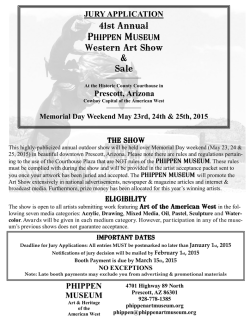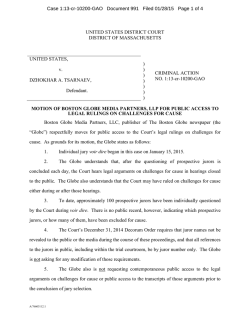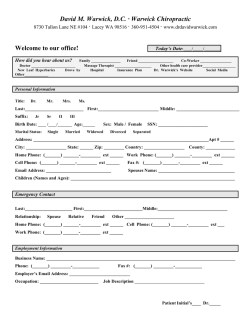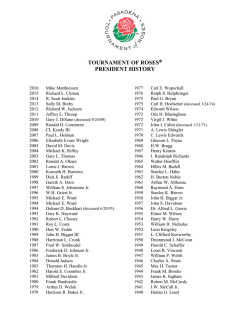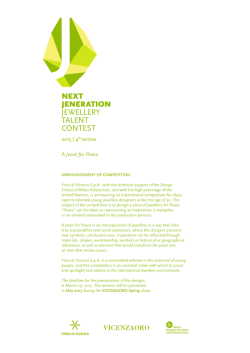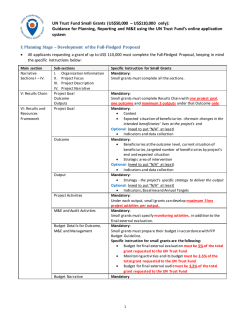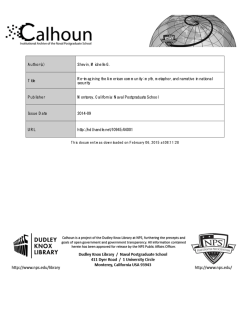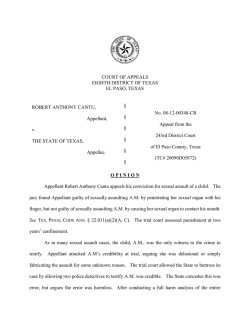
Guidance No.17 Conclusions - Courts and Tribunals Judiciary
GUIDANCE No.17 CONCLUSIONS: SHORT-FORM AND NARRATIVE CONTENTS Paragraph INTRODUCTION 1 The statutory framework 4 The Record of Inquest (Form 2) 7 Historical perspective 13 THE THREE STAGES 18 CONCLUSIONS: The alternatives 19 (1) SHORT-FORM CONCLUSIONS 26 (2) NARRATIVE CONCLUSIONS 31 ARTICLE 2 INQUESTS 45 MISCELLANEOUS 56 Standards of proof 56 Particular short-form conclusions 57 Lawful/unlawful killing Suicide Service deaths Accident Misadventure Open conclusion 58 60 64 65 67 68 Neglect 74 All inquests 86 1 INTRODUCTION 1. The purpose of this guidance is to assist coroners in the use of short-form and narrative conclusions and with a view to achieving greater consistency across England and Wales. 1 2. This guidance is not intended to cover all possible aspects of conclusions. It provides a suggested approach, consistent with case law, to making public findings and conclusions clear, accessible and complete. This will benefit all who attend inquests, in particular families, as well as the media. It will also assist the important process of recording for statistical purposes. 3. In considering conclusions it must always be borne in mind that in essence an inquest is a fact-finding inquiry. ‘It is clear first that the coroner’s over-riding duty is to inquire ‘how’ the deceased came by his death …’: Homberg. 2 The statutory framework 4. The Coroners and Justice Act 2009 (the 2009 Act) and the 2013 Rules and Regulations no longer use the word ‘verdict’. Verdicts have become conclusions. 5. The outcome of an inquest is now recorded in the Record of Inquest (Form 2). This document replaces the Inquisition document (formerly Form 22, Coroners Rules 1984). The format in Form 2 is not dissimilar to an Inquisition. A copy of the Form 2 Record of Inquest is attached at Annex A. 6. As section 10 of the 2009 Act requires, the coroner (or the jury if there is one) must make a ‘determination’ of the matters to be ascertained by the investigation and make ‘findings’ for registration purposes. The matters to be ascertained by the investigation into a person’s death are: who the deceased was; how, when and where the deceased came by his or her death (section 5). The findings for registration purposes are the particulars required by the Births and Deaths Registration Act 1953 (see Form 2 at Annex A). The requirement for both is emphasised by Rule 34. The statutory findings are not to be confused with findings of fact (see below). The Record of Inquest (Form 2) 7. The section 10 ‘determination’ and ‘findings’ must, therefore, be recorded in the Record of Inquest (Form 2, see Annex A). 8. The Record of Inquest will also show the medical cause of death and the conclusion, short-form or narrative. 9. The Record will show who the deceased was in Box 1, the medical cause of death in Box 2, the how, when and where the deceased came by his or her death in Box 3, the conclusion in Box 4, and the particulars required for death registration in Box 5. 1 As always I am very grateful for the input of many coroners into this Guidance, in particular Christopher Dorries, Coroner for South Yorkshire West. I am also indebted to Kate Brunner, barrister of Albion Chambers, Bristol, for her research. 2 R v HM Coroner for Western District of East Sussex, ex parte Homberg (1994) 158 JP 453. 2 10. This guidance focuses primarily on the matters to be included in Boxes 3 and 4 and their inter-relationship. 11. The Record will be signed by the coroner and by the jury if there is one (by those jurors who agree with it). 12. The Record should normally be treated as a public document. Most if not all of the details on it will have been read out in open court and as with documents ‘in the possession of a coroner in connection with an investigation’ it may be provided to any person’ unless they are not ‘in the opinion of the coroner … a proper person to have possession of it’ (which should be rare): see Regulation 27(2). The Record should therefore normally be made available for inspection by the public (including the media) at a coroner’s office on request. In the publicly available copy the signatures of jurors should be redacted. Similarly, other details, such as the address of the deceased, may be redacted where there is good reason for doing so. Details should not be redacted unless it is in the public interest to do so. Historical perspective 13. The precedents in the Appendix to the first edition of Jervis in 1829 show that inquisitions at that time were in narrative form, explaining for example how the deceased ‘in manner and by means aforesaid, accidentally, casually, and by misfortune, came to his death’ (pp368-369), by reference to the facts as found. 14. The origins of some short-form verdicts (conclusions) are relatively recent: see for example unlawful killing explained in Wilkinson 3 and lawful killing in Duggan. 4 Section 4 of the Coroners Act 1843 had referred to ‘a Verdict of Accidental Death’, but a list of short-form verdicts, recognisable to modern day coroners, did not appear until the Coroners Rules 1953. 5 15. However, a clear distinction had been made between ‘circumstances of the death’ and ‘the conclusion of the jury as to the death’ as long ago as the Coroners Act 1887, the cornerstone of modern coroner law. The precedent for the Form of Inquisition described ‘circumstances of the death’ as including facts over and above the medical cause of death. One example given was ‘That the said CD did on the … day of … fall into a pond of water situate at … by means whereof he died’. The precedent suggests in that scenario alternative verdicts of ‘CD, not being of sound mind, killed himself’ or ‘CD by misadventure fell into the said pond and was killed’. 16. That distinction remains although there have been changes in the wording of matters which must be recorded. Form 22 of the Coroners Rules 1984 required certain matters to be found. In Box 2, those matters were ‘Injury or disease causing death.’ In Box 3 they were: ‘Time, place and circumstances at or in which injury was sustained’. Form 2 in the Schedule to the 2013 Rules uses different wording. In Box 2 it is the ‘Medical cause of death’ and in Box 3 it is ‘How, when and where and, for investigations where section 5(2) of the Coroners and Justice Act 2009 applies [Article 2 inquests], in what circumstances the deceased came by his or her death’. 3 R (Wilkinson) v HM Coroner for the Greater Manchester South District [2012] EWHC 2755. R (Duggan) v HM Assistant Deputy Coroner for the Northern District of North London [2014] EWHC 3343 (Admin). 5 See Notes to Form 18 (the Inquisition) in the Third Schedule (see also Rule 42). 4 3 17. As the law has developed the position has now been reached that the coroner (or the jury if there is one) must, in addition to finding the ‘medical cause of death’ (Box 2), make two key decisions: (1) findings of fact as to ‘how’ the deceased came by his or her death (Box 3), and (2) the conclusion as to the death (Box 4). These two decisions are separate but they must be closely related (see below). THE THREE STAGES 18. The coroner (or the jury if there is one) is required, having heard the evidence, and in addition to deciding the medical cause of death (Box 2), to arrive at a conclusion by way of a three stage process. (1) To make findings of fact based upon the evidence. Where the coroner sits alone the key findings of fact should be stated orally in open court, preferably (during or) after the evidence has been summarised (but not written on the Record of Inquest). Where there is a jury they need to be directed to make findings of fact for themselves based upon the evidence they have heard. They will not normally record these findings of fact publicly except insofar as they form part of the answer to ‘how’ or part of a narrative conclusion. (2) To distil from the findings of fact ‘how’ the deceased came by his or her death and to record that briefly in Box 3. Normally, the answer to ‘how’ will be a brief one sentence summary taken from the findings of fact in (1) above. ‘How’ means ‘by what means’ (and not ‘in what broad circumstances’). 6 This will usually be a description of the mechanism of death. Examples of ‘how’ in Box 3 are: ‘by hanging from an exposed beam using a ligature made from a bedsheet’ (with the conclusion of ‘suicide’ entered in Box 4) ‘by drowning while swimming from his small fishing boat in the open sea’ (with the conclusion of ‘misadventure’ entered in Box 4) ‘from injuries caused in a motor collision while a backseat passenger in her father’s car’ (with the conclusion of ‘road traffic collision’ entered in Box 4) ‘from trauma consistent with an un-witnessed fall downstairs’ (with the conclusion of ‘accident’ entered in Box 4) 6 R v HM Coroner for North Humberside and Scunthorpe, ex parte Jamieson [1995] QB 1. In Article 2 cases it means ‘by what means and in what circumstances’ (section 5(2) of the 2009 Act; R (Middleton) v HM Coroner for West Somerset [2004] 2 AC 182). 4 ‘by exposure to asbestos fibres during the course of his occupation as a plumber’ (with the conclusion of ‘industrial disease’ entered in Box 4) To these words will be added the date and place of death where known and, where necessary, any further words which briefly explain how the deceased came by his/her death. (Box 3) For example in a case of bad driving falling short of manslaughter: 7 ‘The unknown driver left the scene without stopping. He had been travelling at high speed down an ill-lit narrow street, knocking into parked cars, before he struck and knocked down the deceased who was walking along the side of the road, causing the injuries from which he died. (Box 3) I shall therefore record the formal conclusion [under the law/as required by law] as accident OR road traffic collision.’ (Box 4) Coroners, in their judicial discretion, will use their own form of words. These should be brief, neutral and clear. As under the old law they must not include opinion other than on matters which are the subject of statutory determination (section 5(3), the 2009 Act) and they must not appear to determine any question of criminal liability on the part of a named person or civil liability (section 10 (2)). (3) To record the conclusion, which must flow from and be consistent with (1) and (2) above, in Box 4. CONCLUSIONS: The alternatives 19. There are two alternatives for conclusions which are sanctioned by the Coroners and Justice Act 2009, the Coroners (Inquests) Rules 2013 and the common law as expounded in case law: (1) a short-form conclusion and (2) a narrative conclusion. It is also permissible to combine the two types of conclusion. 20. The conclusion, short-form or narrative, must be entered in Box 4 of the Record of Inquest. 21. There must always be sufficient evidence on a Galbraith plus basis for a conclusion. 8 22. It is for the coroner to decide whether a short-form or a narrative conclusion is more appropriate to the case in question. 23. In more complex cases where interested persons are represented, the coroner will invite submissions on the following: 7 8 the type of conclusion, short-form or narrative; the short-form conclusions the coroner is considering leaving to the jury; what written directions (if any) will be given to the jury; and what questions (if any) may be asked of them. See Chief Coroner’s Law Sheet No.1, Unlawful Killing, paragraph 41. See Chief Coroner’s Law Sheet No.2, Galbraith Plus. 5 The coroner should ‘prepare a draft written statement of the matters which he/she believes the law requires in relation to the possible verdicts’. 9 (Legal representatives could be invited to submit a first draft.) The coroner must give a ruling about these matters with ‘short reasons’. 10 Written directions of law 24. In jury cases of any complexity, a coroner should draft written legal directions, which should be circulated to interested persons to allow any submissions to be made. 11 Those directions should include directions as to the order in which the jury should consider conclusions, and the standard(s) of proof. The jury should be directed to consider conclusions where the criminal standard applies before those where the civil standard applies. 12 25. It is good practice, where time permits, for the coroner to hand to the jury the directions of law in full and then to read them out ‘for the record’. 13 In this way, particularly in complex cases, the jury will be able to revisit any of the directions when they have retired without having to rely on their memory or notes. (1) SHORT-FORM CONCLUSIONS 26. Wherever possible coroners should conclude with a short-form conclusion. This has the advantage of being simple, accessible for bereaved families and public alike, and also clear for statistical purposes. 27. The short-form conclusion should be one from the list of short-form conclusions in Note (i) of Form 2 in the Schedule to the 2013 Rules (copied at Annex A). As before (old Form 22) the list is not exclusive, 14 but straying from the list will usually be unwise. It should be noted that there are two new short-form conclusions in the 2013 list: ‘alcohol/drug related’ and ‘road traffic collision’. ‘Alcohol/drug related’ may be split into ‘alcohol related’ or ‘drug related’. 28. Even in a complex case a short-form conclusion in Box 4, in combination with the answer to ‘how’ in Box 3, will often be sufficient to ‘seek out and record as many of the facts concerning the death as the public interest requires’, per Lord Lane CJ in Thompson. 15 For example, the options may be unlawful killing, lawful killing and open conclusion; or, in another case, suicide, accident or open conclusion. But as always the conclusion in Box 4 must flow from and be consistent with the findings of fact and the answer to ‘how’ in Box 3. 29. Where a short-form conclusion is left to a jury in a complex case, the coroner should normally help the jury: (i) identifying key questions of fact for them to 9 R (Sreedharan) and HM Coroner for Greater Manchester [2012] EWHC 1386 at [31]. Sreedharan, above, at [31]; R (Cooper) v HM Coroner for North East Kent [2014] EWHC 586 (Admin). 11 Wilkinson, note 3, at [18]; R v Inner South London Coroner, ex parte Douglas-Williams [1999] 1 All ER 344, 355. 12 As recommended in R v Wolverhampton Coroner, Ex Part McCurbin [1990] 1 WLR 719 at 728C-D. 13 ‘Obviously, it is normal and good practice for the judge to provide written directions of law and also written routes to verdict’: R v Bennett [2014] EWCA Crim 2652 at [63]. 14 See R v Inner South London Coroner, ex parte Kendall [1988] 1 WLR 1186. 15 R v South London Coroner, ex parte Thompson (1982) 126 SJ 625. 10 6 decide, when they come to answer the ‘how’ question (Box 3); and (ii) providing written directions of law with assistance on their conclusion (Box 4). 30. The following is an example of a direction to a jury in a more complex case on ‘how’ the deceased came by his death (Box 3) as a precursor to their consideration of a short-form conclusion (Box 4): ‘Members of the jury, in dealing with the requirement in Box 3 of the Record of Inquest to decide how [the deceased] came by her death you might like to consider the following questions as part of your investigation into the death. [LIST QUESTIONS] There may be other questions which you consider important. I am not telling you what to say. What you find and how you express it is entirely a matter for you. I am merely helping you with the sort of words you might write under this heading if you so choose. In answering the question how she came by her death you must make findings of fact. The law says that you must not make recommendations or express opinions. And your findings of fact must, of course, not only be brief, neutral and clear but they must also be based upon the evidence which you have seen and heard in court, from witnesses and in documents and from the CCTV evidence. Once you have agreed the facts, then and only then should you move on to consider your conclusion under Box 4 of the Record of Inquest. Let me now direct you about the possible conclusions. [BOX 4 DIRECTIONS] (2) NARRATIVE CONCLUSIONS 31. As an ‘alternative’ to a short-form conclusion the coroner (or the jury if so directed by the coroner) may record a ‘brief narrative conclusion’ in Box 4: see Note (ii) to Form 2. 32. Note (ii) also states that a narrative conclusion may be used ‘in addition’ to a short-form conclusion. This means that a narrative may be used as a brief expansion of the stated short-form conclusion in Box 4, 16 although in most cases this will not be necessary because of the words already used in answering ‘how’ in Box 3. 33. A narrative conclusion is a conclusion and should therefore be entered in Box 4. Where the narrative conclusion includes clearly the answers to ‘how, when and where’, Box 3 could be completed in this way: ‘See Box 4’. But the better way is to record the mechanism of death under ‘how’ in Box 3 and the wider narrative conclusion in Box 4. 34. A narrative conclusion should be a brief, neutral, factual statement; it should not express any judgment or opinion. 17 The requirement of brevity has been 16 See Ruling on Verdicts of Scott Baker LJ in The Coroner’s Inquests into the Deaths of Diana, Princess of Wales, and Mr Dodi Al Fayed at http://webarchive.nationalarchives.gov.uk/20090607230252/http://www.scottbakerinquests.gov.uk/docs/ruling_on_verdicts_270308.pdf. See also R (P) v HM Coroner for Avon [2009] EWCA Civ 1367 at [28], approving a short-form conclusion with ‘a narrative appended to it’: see paragraph 55 below. 17 Jamieson, note 6, at p24, General conclusion (6); see also R (Hurst) v London Northern District Coroner [2007] 2 AC 189. Cf Article 2 narratives at paragraph 51. A narrative conclusion should avoid being ‘bland’ or ‘anodyne’, in the sense that it adds ‘nothing of significance to anyone’s 7 emphasised repeatedly: see Jamieson, 18 Middleton, 19 Clayton 20 and Scholes. 21 A few sentences or one or two short paragraphs at the most will be sufficient. In Jamieson 22 the Court of Appeal stated that ‘It is not the jury’s function to prepare detailed factual statements.’ 35. There has been a tendency for narrative conclusions from coroners to become lengthy and far-reaching, both as statements and in questionnaires to juries (see below). That is not what the authorities envisage. Long narratives should not be given. They achieve neither clarity nor accessibility in that form. They make it difficult to assess for statistical purposes. 36. Narrative conclusions are not to be confused with findings of fact in the three stage process. If the three stage process of (1) findings of fact, (2) the answer to ‘how’, and (3) a short-form conclusion is properly followed, there will often be no need for a narrative conclusion. In general a narrative conclusion should be used only where the three stage process (culminating in a short-form conclusion) is insufficient to ‘seek out and record as many of the facts concerning the death as the public interest requires’: per Lord Lane CJ in Thompson. 23 37. By way of example a short-form conclusion may be insufficient for these purposes where the jury would wish to express a conclusion in a prison death case on a major issue such as procedures leading to two persons sharing a cell together: see Middleton. 24 38. Narrative conclusions must be directed to the issues which are ‘central’ to the cause of death, nothing more: Allen; 25 or to the ‘disputed factual issues at the heart of the case’ or ‘core issues which the inquest raised’: Cash; 26 the important issues’: Smith. 27 The coroner does not have to state a conclusion on every issue raised (only those above): Allen. 39. Where a jury is invited to write a narrative, the coroner may elicit the conclusion by a number of different methods. Normally the coroner will identify the issues or areas of fact which the jury needs to address, guiding them with examples of possible narrative conclusions, without of course telling them what to find. 40. As an alternative, the coroner may choose to provide the jury with written questions in the form of a questionnaire. In such cases the questions and answers will stand as the narrative conclusion. They will become part of the Record of Inquest and will be read out in public. See, for example, the five written central questions which the coroner asked of the jury in Duggan, above, as a precursor to considering alternative conclusions of unlawful killing, lawful knowledge of the circumstances’ surrounding the death: R (Cash) v HM Coroner for Northamptonshire [2007] EWHC 1354 (Admin) at [49]; [2007] 4 All ER 903. 18 Jamieson, note 6. 19 Middleton, note 6. 20 R (Clayton) v South Yorkshire Coroner [2005] EWHC 1196. 21 Scholes v SSHD [2006] EWCA Civ 1343. 22 Note 6. 23 Note 15. 24 Middleton, note 6, at [31], referring to the major issue in Amin. 25 R (Allen) v HM Coroner for Inner North London [2009] EWCA Civ 623, [33]. 26 Cash, note 17. 27 Smith v Assistant Deputy Coroner for Oxfordshire [2006] EWHC 694 (Admin). 8 killing and open conclusion. A questionnaire should not be lengthy: see Clayton and Scholes, above. 41. Narrative conclusions may be used in Article 2 and non-Article 2 cases: see Longfield Care Homes. 28 42. Narrative conclusions may be useful in non-Article 2 cases where the death arises from more than one cause (Longfield Care Homes above). 43. But the House of Lords seems to have decided in Hurst, 29 reaffirming the difference between Jamieson (non-Article 2) and Middleton (Article 2) inquests, that in non-Article 2 inquests narrative verdicts involving systemic failings should not be wide-ranging, even where the state is involved (police and housing authority). 44. Although coroners will use their own words (when sitting without a jury), in the exercise of their judicial discretion, the following is an everyday example of a narrative conclusion: ‘He/she died from a complication of necessary medical treatment OR of a necessary surgical procedure’. ARTICLE 2 INQUESTS 45. The conclusion in an Article 2 case may be in short-form or narrative form (or a combination of the two 30). 46. In an Article 2 inquest, the coroner must record ‘in what circumstances’ the deceased came by his or her death (section 5(2), 2009 Act). The inquest must enable the coroner or the jury to express their conclusions on the central issue(s) canvassed at the inquest. 47. A short-form conclusion may be sufficient to enable the jury to express their conclusion on the central issues canvassed at inquest. 31 Frequently a narrative conclusion will be required in order to satisfy the procedural requirement of Article 2, including, for example, a conclusion on the events leading up to the death or on relevant procedures connected with the death: see Middleton. 32 48. As Lord Bingham stated in Middleton 33 it is for the coroner, in the exercise of his discretion, to decide how best in the particular case to elicit the jury’s conclusion on the central issue(s), including disputed factual issues at the heart of the case: ‘This may be done by inviting a form of verdict expanded beyond those suggested in … the Rules. It may be done … by inviting a narrative form of verdict in which the jury’s factual conclusions are briefly summarised. It may be done by inviting the jury’s answers to factual questions put by the coroner … It would be open to parties appearing or represented at an inquest to make submissions to the coroner on the means of eliciting the jury’s factual conclusions and on any questions to be put, but 28 R (Longfield Care Homes) v HM Coroner for Blackburn [2004] EWCH 2467 (Admin), [28] - [31]. Hurst, note 17. See R (Smith) v Oxfordshire Assistant Deputy Coroner [2011] 1 AC 1. 30 See R (P) v HM Coroner for Avon [2009] EWCA Civ 1367, and paragraphs 19 and 32, above, and 55, below. 31 McCann, McCann v United Kingdom (1995) 21 EHRR 97; Hurst, above, at [48]. 32 Note 6. 33 Note 6, at [20], [36] and [45]. 29 9 the choice must be that of the coroner and his decision should not be disturbed by the courts unless strong grounds are shown.’ 49. What should be included in Article 2 narrative conclusions? Narratives can include, following Middleton, ‘causes of death, defects in the system which contributed to death and any other factors relevant to the circumstances’. They must culminate in an expression of the jury’s conclusions on the ‘central issues’. 34 The jury must be directed to the ‘disputed factual issues at the heart of the case’ or ‘core issues which the inquest raised’: Cash. 35 50. A narrative conclusion may (but does not have to) include factual findings on matters which are possible but not probable causes of death where those findings will assist a coroner in a Report to Prevent Future Deaths: Lewis. 36 Otherwise, a narrative verdict must only include matters which are ‘causative in terms of the death’ or ‘relevant in terms of causation of death’ or ‘part of the chain of causation that led to the death’. 37 51. A conclusion in an Article 2 case may be a ‘judgmental conclusion of a factual nature [on the core factual issues], directly relating to the circumstances of death’, without infringing either section 5(3) of the 2009 Act (limiting opinion) and section 10(2) (avoiding questions of civil or criminal liability). 38 52. Permitted judgmental words include ‘inadequate’, ‘inappropriate’, ‘insufficient’, ‘lacking’, ‘unsuitable’, ‘unsatisfactory’, and ‘failure’. 39 It is unlawful to direct a jury in an Article 2 case in such a way that they were prevented from entering ‘a judgmental conclusion of a factual nature’. 40 Words denoting causation such as ‘because’ and ‘contributed to’ are permissible. 41 53. On the other hand words which suggest civil liability such as ‘negligence’, ‘breach of duty’, breach of Article 2’ and ‘careless’ are not permitted as they may breach Section 10(2), 2009 Act. 54. In Scholes Pill LJ said that the jury’s conclusions on factual issues were helpful, but their views on policy issues less so. 42 55. In the Avon case, the Court of Appeal concluded in a prison death case that once the jury had resolved the issue of suicide or accident they could only have addressed the issue of ‘whether the system for prevention of suicide or selfharm merited criticism’ by ‘appending a narrative’. There was ‘a public interest in their being given a clear opportunity to express their findings in narrative form’. 43 34 Middleton, note 6. Cash, note 17. See paragraph 38. 36 R(Lewis) v HM Coroner for the Mid and North Division of Shropshire [2010] 1 WLR 1836. 37 Directions on causation at first instance approved as ‘lawful and sensible and cannot be faulted’ by the High Court in Lewis, note 36. 38 Middleton, note 6, at [37]. 39 Middleton, note 6; Lewis, note 36; Smith, note 27. 40 Cash, note 17, at [51]-[52]; Lewis, note 36. 41 Middleton, note 6; Lewis, note 36. 42 Scholes, note 21, at [69] – [70]. 43 See Avon, note 16, at [26] and [28]. 35 10 MISCELLANEOUS Standards of proof 56. The standard of proof required for the short-form conclusions of ‘unlawful killing’ and ‘suicide’ 44 is the criminal standard of proof. For all other short-form conclusions and a narrative conclusion the standard of proof is the civil standard of proof. See Note (iii), Form 2, Schedule to the 2013 Rules. Particular short-form conclusions 57. Guidance will not be provided here on all short-form conclusions, only on some. Lawful/unlawful killing 58. For the conclusion of lawful killing see the decision of the High Court in Duggan, above. 45 59. For the conclusion of unlawful killing see the decision in Wilkinson above 46 and the Chief Coroner’s Law Sheet No.1. Suicide 60. It is not proposed in this guidance to set out the law relating to the short-form conclusion of ‘suicide’ (Form 2). But three points need to be made in the context of conclusions. 61. First, the conclusion of suicide should not be avoided by coroners simply out of sympathy for family relatives or for any other reason. Parliament has decided that suicide should remain as a short-form conclusion. The word ‘suicide’ is expressly used in the Rules: see Note (i), Form 2, Schedule, Coroners (Inquests) Rules 2013. It is therefore the coroner’s judicial duty, when suicide is proved on the evidence, to record the conclusion of suicide according to the law and the findings which justify it. It would be wrong, for example, to record an ‘open’ conclusion when the evidence is clear. 47 62. Secondly, coroners should make express reference in each case of possible suicide to the two elements which need to be proved: (i) [the deceased] took his/her own life; and (ii) [the deceased] intended to do so (or, put together, ‘he/she intentionally took his/her own life’). Both elements must be proved to the criminal standard of proof. 48 Suicide must never be presumed. 49 Where suicide is not found the coroner should explain why, for example: ‘Looking at the two elements which must be proved to the higher standard of proof before a conclusion of suicide can be recorded, I am satisfied that [the deceased] took his own life, but I am not satisfied that he intended to do so. I cannot be sure 44 There is an ongoing discussion as to whether suicide should be proved to the criminal or civil standard. The Ministry of Justice are considering the alternatives. 45 Note 4. 46 Note 3. 47 ‘The job of the judges is to apply the law, not to indulge their personal preferences’: Lord Bingham in The Rule of Law (2010). 48 See R ( Lagos) v HM Coroner for City of London [2013] EWHC 423 (Admin). 49 R v City of London Coroner, ex parte Barber [1975] 1 WLR 1310. 11 about it. It is in my judgment more likely than not that he had that intention, but on the evidence looked at as a whole I cannot rule out that this was a terrible accident. For those reasons my conclusion is not suicide or accident but an open conclusion.’ Or as Pill LJ concluded in Hopper: 50 ‘The facts and circumstances in this case did not, in my judgment, point irresistibly to the existence of a suicidal intent. The possibility that the discharge of the gun was accidental could not be excluded as a reasonable possibility.’ 63. Thirdly, coroners may wish to alleviate the impact of the conclusion of suicide where proved with a form of words such as: ‘Those findings of fact lead me therefore to the following inevitable conclusion. I am satisfied to the relevant standard of proof that [the deceased] took his own life and intended to do so. For the purposes of the law I must therefore record the formal conclusion as suicide.’ There is usually no longer any need to add the words ‘whilst the balance of his mind was disturbed’. Service deaths 64. Similarly, in a service death inquest where the deceased was killed by insurgents and the words ‘unlawful killing’ used alone may sound inappropriate, the final words could be: ‘I shall record that [the deceased] died in the line of duty while on active service. For the purposes of the law I must record the formal conclusion as unlawful killing.’ Accident 65. Some authorities have approved additional words in accident cases such as ‘the deceased was killed when his car was run down by an express train on a level crossing’, or ‘the deceased was drowned when his sailing dinghy capsized in heavy seas’: Jamieson. 51 The phrase ‘accidental death’ may also be used. 66. But these instances are not narrative conclusions within the modern postMiddleton meaning of that phrase. They are akin to the 1887 Act descriptions of the circumstances of death. They may therefore be used to answer the ‘how’ in Box 3, leaving the short-form conclusion of ‘accident’ to stand alone in Box 4. Misadventure 67. Misadventure may be used as a conclusion; it remains on the list (Form 2). Misadventure may be the right conclusion when a death arises from some deliberate human act which unexpectedly and unintentionally goes wrong. Open conclusion 68. Open conclusions are to be discouraged, save where strictly necessary. An open conclusion should ‘only be used as a last resort, notably when the coroner 50 R v Essex Coroner ex parte Hopper ILR 23 May 1988. Jamieson, note 6. See also Kendall, note 14; HM Coroner for North London, ex parte Sutovic [2008] EWHC 1095 (Admin), [96] - [99]. 51 12 [or the jury] is simply unable to reach any conclusion on the balance of probabilities as between two competing verdicts’: Tabarn. 52 69. Put another way, an open conclusion is the only conclusion when the evidence fails to satisfy the coroner or the jury (to the appropriate standard of proof) that another short-form conclusion (or some necessary element of it) has been proved. For that reason open conclusion does not have its own standard of proof. 70. Where an open conclusion is left to a jury with one or more other short-form conclusions, the coroner should tell them (a) not to use the conclusion because they disagree amongst themselves on the other short-form conclusion(s), and (b) if they do come to an open conclusion not to consider that they will be criticised for it or that they have failed in their duty in any way. 71. Where the conclusion is an open one, Box 3 still needs to be completed, including ‘how’. 72. An open conclusion once entered and recorded may not be revisited at a later date without the intervention of the High Court. 73. In some cases a narrative conclusion will be preferable to an open conclusion. A narrative will give the coroner (or jury) the opportunity to state what findings are made and what are not. Or alternatively (as in the suicide example at paragraph 62 above), the open verdict can have extra words appended by way of explanation. Neglect 74. The following does no more than outline the concept of neglect in coroner law. Neglect is not a conclusion in itself. It is best described as a finding. It must be recorded as part of the conclusion (in Box 4). 53 It has a restricted meaning according to the case law. It should not be considered as a primary cause of death. 75. A finding of neglect (formerly lack of care) was specifically approved in Jamieson. 54 It may form part of the conclusion in Box 4, either as words added to a short-form conclusion (see paragraph 32 above) or as part of a narrative conclusion. 76. Neglect is narrower in meaning than the duty of care in the law of negligence. 55 It is not to be equated with negligence or gross negligence. It is limited in a medical context to cases where there has been a gross failure to provide basic medical attention. 77. The deceased must have been in a dependent position (because of youth, age, illness or incarceration): see next paragraph. 78. Neglect was defined in Jamieson 56 (a hanging in prison) in this way: 52 In Re Tabarn [1998] EWHC (Admin) 8, at [50]. R v West London Coroner, ex parte Gray [1988] QB 467. 54 Jamieson, note 6 above, at General conclusions (8)-(10). 55 See R v HM Coroner for South Yorkshire, ex parte Stringer (1993) 17 BMLR 92; Homberg, note 2. 56 Jamieson, note 6, at page 25. 53 13 ‘(9) Neglect in this context means a gross failure to provide adequate nourishment or liquid, or provide or procure basic medical attention or shelter or warmth for someone in a dependent position (because of youth, age, illness or incarceration) who cannot provide it for himself. Failure to provide medical attention for a dependent person whose position is such as to show that he obviously needs it may amount to neglect …’ 79. This definition has been expanded more by illustration than by changes in the law, testing the words ‘gross failure’ and ‘basic’ against particular facts. In broad terms there must be ‘a sufficient level of fault’ to justify a finding of neglect. 57 That does not mean that, for example in a medical context, there has to have been no action at all, 58 simply that the action (or lack of it) on an objective basis must be more than a failure to provide medical attention. It must be a gross failure. The difference will be highly fact-specific. 59 80. In a medical context it is not the role of an inquest to criticise every twist and turn of a patient’s treatment. Neglect is not concerned with the correctness of complex and sophisticated medical procedures but rather the consequences of, for example, failing to make simple (‘basic’) checks. 60 81. In prison death cases, ‘only in the most extreme circumstances (going well beyond ordinary negligence) could neglect be properly found to have contributed to that cause of death’: Middleton. 61 82. There must be a clear and direct causal connection between the conduct described as neglect and the cause of death: Jamieson. 62 The conduct must have caused the death in the sense that it ‘more than minimally, negligibly or trivially contributed to the death’: see Khan. 63 The ‘touchstone’ is ‘the opportunity of rendering care … which would have prevented death: Staffordshire case. 64 It is not enough to show that there was a missed opportunity to render care which might have made a difference; it must be shown that care should have been rendered and that it would have saved or prolonged life (not ‘hastened’ death): Khan. 65 [emphasis added] 83. Neglect must be shown on a balance of probabilities. A ‘real possibility’ is not enough: Khan 66. 84. The phrase ‘aggravated by neglect’ should not be used, nor should ‘lack of care’. A better phrase is that neglect (being the conduct which amounted to neglect) contributed to the cause of death. 85. In Longfield Care Homes 67 the High Court stated that cases in which neglect may be found to have contributed to death by self-harm or accident would be rare and would arise only where neglect was gross and a clear or direct causal 57 R (Khan) v HM Coroner for West Hertfordshire [2002] EWHC 302 (Admin) at [44]. See for example R (Davies) v Birmingham Deputy Coroner [2003] EWCA Civ 1739. 59 See R (Nicholls) v HM Coroner for City of Liverpool [2001] EWHC Admin 922. 60 Nicholls, note 59. 61 Middleton, note 6, at [28], summarising Jamieson at pp25-26. 62 Jamieson, note 6, at p25A, point (12). See also Khan, note 57. 63 Khan, note 57, at [25], [43]. 64 R v HM Coroner for Coventry ex parte Chief Constable of Staffordshire (2000) 164 JP 665, 675-676. 65 Khan, note 57, at [43]. 66 Ditto. 67 See note 28. 58 14 connection established. The jury’s verdict of accident aggravated by neglect was replaced by the Court with the following narrative statement: ‘Mrs Hall died of bronchopneumonia resulting from dementia. Her death was probably accelerated by a short time by the effect on her pneumonia of injuries sustained when she fell through an unattended open window, which lacked an opening restrictor, in the lounge of Longfield Residential Home on 16 April 2003.’ All inquests 86. Coroners should at all times use moderate, neutral and well-tempered language, befitting the holder of a judicial office. Coroners should not make any other observations of any kind, however well intentioned, outside the scope of a report on action to prevent future deaths under the provisions of paragraph 7 of Schedule 5 to the 2009 Act. 68 Such observations are an expression of opinion wider than is permissible (under section 5(3) of the 2009 Act, the old rule 36) and are therefore unlawful and to no effect: see Mowlem 69 and Farah. 70 87. Juries may no longer give riders or otherwise make recommendations. 71 HH JUDGE PETER THORNTON QC CHIEF CORONER 30 January 2015 68 See Chief Coroner’s Guidance Nos.5 and 5A. R (Mowlem plc) v Avon Assistant Deputy Coroner [2005] EWHC 1359 (Admin). 70 R (Farah) v HM Coroner for Southampton and New Forest District of Hampshire [2005] EWHC 1359 (Admin). 71 See Jamieson, note 6, at p14. 69 15 ANNEX A FORM 2: RECORD OF AN INQUEST 16
© Copyright 2026
![1963. No. 199 [C] The Ministry of Home Affairs](http://s2.esdocs.com/store/data/000486728_1-38a6dfa904cb21b58d692809ea0acc3f-250x500.png)
